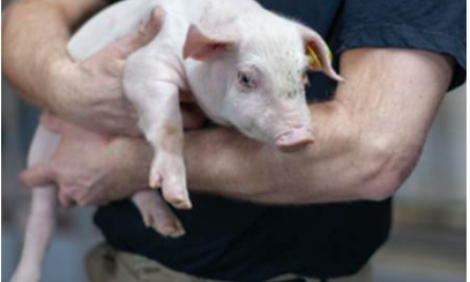



Feeder Management – Fine Tuning Your Feeders
Research from Kansas State University suggests that optimum feeder gap setting may differ with growth phase, according to Doug Richards, Swine Grower-Finisher Specialist with OMAFRA in the latest Pork News and Views from Ontario's Ministry of Agriculture.When adjusting feeders, the gap between the agitation plate and the trough floor will determine the amount of feed that can flow into the feeder. If the feeder gap is too narrow, it can restrict the amount the pig may eat and in some cases cause the feeder to plug. One plugged feeder space in a four-hole feeder can easily be overlooked until the whole feeder becomes plugged. The end result can mean longer days to market for the pig and increased costs to the producer. The opposite to that is having the feeder gap too large, which prevents plugging but results in feed wastage and increased feed cost. The optimum solution is to adjust the feeder to maximize pig growth while limiting feed wastage. The question is, "What is that optimum feeder gap spacing?"
Kansas State University (KSU) research on swine feeder adjustment presented at KSU 2008 Swine Days by A. W. Duttlinger, noted that pan coverage of 45 to 50 per cent would be a good average on the basis of the data, and the recommendation was for feeders to be adjusted to allow feed to cover slightly more than half of the feed pan without feed accumulating in the corners.
More trials on feeder adjustment presented at Swine Day 2010 by KSU provide a very timely update, given the current price of pig feed. Below is a summary of their findings that can help reduce the largest expense in finishing market hogs – the cost of feed.
The objective of the study, ‘The Effects of Feeder Adjustment on Growth Performance of Finishing Pigs’ by A.J. Myers, R.D. Goodband, M.D. Tokach, S.S. Dritz1, J.R. Bergstrom, J.M. DeRouchey and J. L. Nelssen, was to determine the ideal feeder adjustment for performance at various growth stages of finishing pigs. They had three different settings on identical feeders. The treatments consisted of a narrow feeder adjustment (minimum gap opening of 0.50in.), medium feeder adjustment (minimum gap opening of 0.75in.), and wide adjustment (minimum feeder gap opening of 1.00in.). The feeders were adjusted to the minimum gap setting, but the agitation plate could be moved upward to a maximum gap opening of 0.75, 1.00 or 1.25in., respectively.
Pigs were put on test at 91.4lbs (average) for 89 days. All pens had the same type of feeder with two 14-inch wide by 4.5-inch deep feeder holes. Pigs had full access to the same feed and water in each pen. Pen weights and feed disappearance were measured every two weeks. Also, pictures of feeders were taken and scored by a panel to determine percentage pan coverage. Results showed that narrow, medium, and wide feeder adjustments averaged approximately 28, 58 and 75 per cent pan coverage, respectively.
The results from the above trial suggest that when pigs first enter the finisher stage at 91lbs., the feeder gap should be set to at least 0.75in., resulting in approximately 58 per cent pan coverage to maximise gain without affecting feed efficiency. However, after pigs reach 150lb., feeders should be adjusted to a 0.50-inch gap width resulting in approximately 28 per cent pan coverage to minimise feed wastage and optimise both average daily gain and feed to gain ratio. Thus, it appears that optimum feeder gap setting may differ with growth phase.
For the complete trial results at Kansas State University, please click here.








